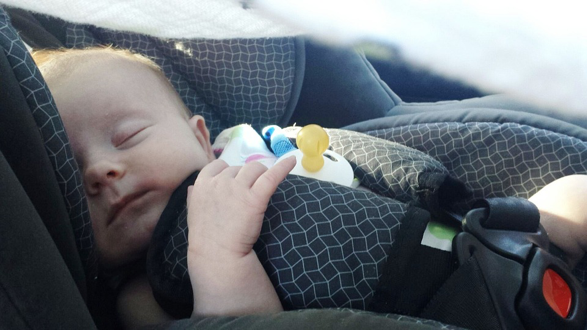Car seat safety is on the mind of every new parent. This is actually a very important question when it comes to newborns and smaller infants. Car seat safety actually depends on the positioning and placement of the infant seat properly. It also depends on what type of car seat you buy. If you are expecting a baby, you should thoroughly research car seats before buying one.

When Can Babies Face Forward In Their Carseat?
Babies can ride in a car seat facing forward when they are 2 years of age, as long as they weigh at least 22 pounds. A child less than 2 years old should always be placed in a rear facing car seat, no matter their weight. For example; if you have a 15 month old that weighs 23 pounds, they should still be in a rear facing car seat.
What is the difference between facing forward and rear facing?
Studies show that babies under the age of two do not have enough neck and spinal muscles to support them and prevent injury. Facing the rear of the car in a collision can help re-distribute the force of impact. Facing the rear of the car can reduce infant death from car accidents by 75 percent. The statistics show that it is 5 times safer than front facing seats.
Buying The Right Car Seat
You landed here because you asked yourself, “when can babies face forward in their car seat?” Now that you know it is best to wait until they are 2 years old, let’s take a look at buying the best seat possible to protect your little one. Here are some different types of infant, toddler and child seats:
Infant Rear Facing Car Seat
An infant rear facing car seat is used for infants only. Their weight range is between 22 and 40 pounds, but you may find the “bucket” style with handles really only work until age one. Babies can get too heavy for parents to carry in the carrier. This style has a separate base that remains installed in your car, and you just click the carrier in.
Infant/Toddler Convertible Seat
These seats are for older babies who are able to sit up, and hold their head up. It looks like a forward facing car seat, but you turn it around so that baby is facing the rear. They do not come in and out of the car, and do not have handles to carry baby in and out. These work for babies up to 50 pounds. When your toddler turns 2 and weighs over 22 pounds, you just flip the seat around and they can face forward.
Infant/Toddler/Child 3 in 1 Convertible Seat
A 3 in 1 convertible seat is first used as a rear facing car seat for older babies, then can be turned around to a forward facing seat. The convenience of buying one of these is the back comes off when they are at least 4 years old and weigh at least 40 pounds, and you can use the base as a booster seat with a regular seat belt.
Helpful Tips For Car Seat Safety and Installation
When can babies face forward? We know the answer. The best way to install your car seat properly is to follow the manufacturer’s instructions that came with the seat. However, some of these tips may be additionally helpful:
- Never place your baby in a seat bundled in coats or blankets. Use a car seat cover and blanket tucked around baby after the straps are buckled.
- You may have to invest in a car seat bed if you have a premature infant. Preemies may not have enough neck control to hold their head up, even in a reclining type seat.
- Make sure you recline the seat far enough to prevent your baby’s head from folding forward to the chest. This can occlude the airways and cause death or injury. Use a rolled blanket or car seat head support.
- If your baby gets fussy facing the rear, try a mirror in the back window so they can see you and you can see them. You can also find approved car seat toys for them to play with.
- Make sure the harness/belts are in the proper slots for the height of their shoulders. This will prevent shoulder compression and discomfort.
- Make sure you use the harnesses that attach the car seat to the body of your car. In newer cars, there are harness anchors usually in the back window and/or below the rear seat. New car seats come with anchor straps to attach to these.
- Your baby’s harness belts need to be tight with no slack. You should only be able to place two fingers under the belts if they are tight enough.
- Don’t worry if your baby’s feet touch the back of your rear seat. As long as the knees don’t push up to the chest and look comfortable, they are fine.
- Check to see if you are using the right belt opening for how you are using your seat. Rear facing car seats usually have a different belt opening than front facing. There is usually a sticker on the side of the seat noting where the belt path is in relation to which way the seat is facing.
- When you place a rear facing carrier seat on its base, make sure it is firmly clicked into place.
- Check to make sure the car seat belt is pulled tightly after clicking into place. Never leave any slack between the vehicle belt and the car seat.
Always place an infant, baby, or child seat in the middle seat when at all possible. Doors can crush in on impact. The middle seat will help protect from both crushing and airbag injuries if you have rear airbags.
